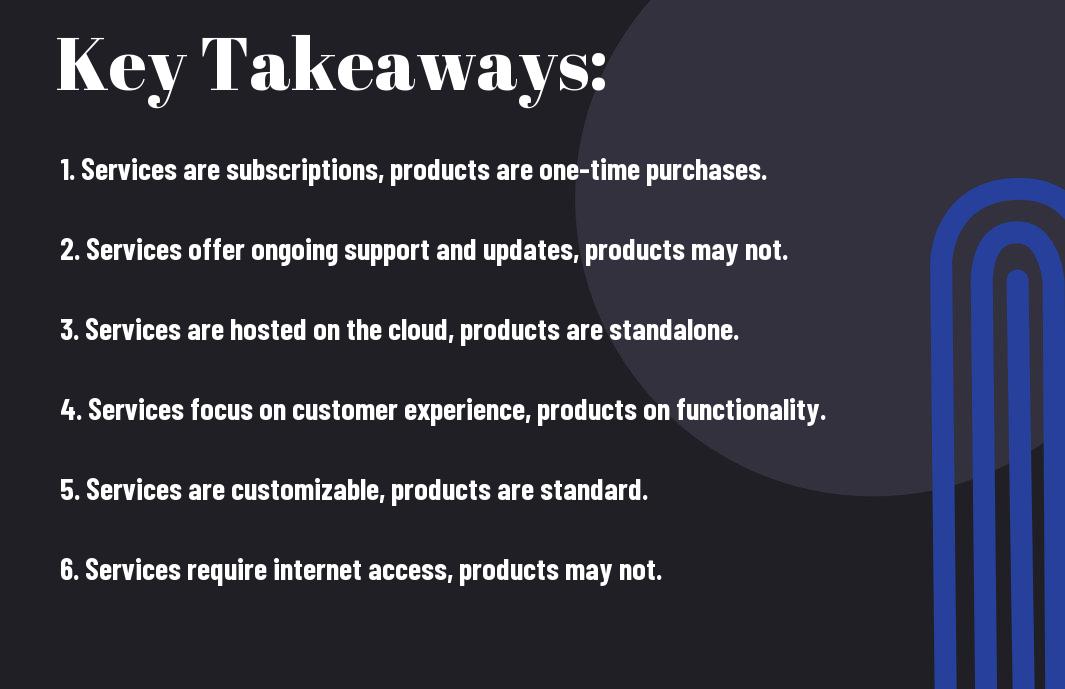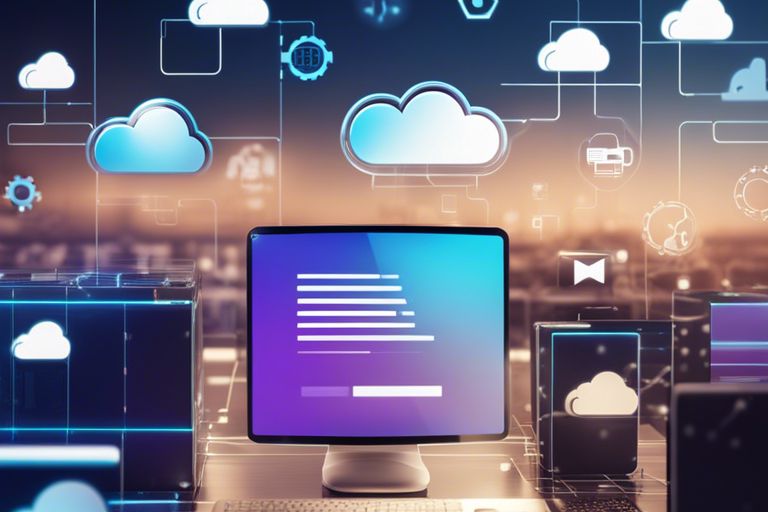Most often, you come across the terms software services and software products in the tech world, but do you truly understand the distinctions between the two? In this post, we investigate into the intricate world of software development to elaborate on what software services entail and how they differ from traditional software products. So, let’s explore this fascinating realm together and gain a deeper insight into the evolving landscape of technology.
Key Takeaways:
- Service-based Model: Software services are based on a service-oriented architecture, where a provider offers a service to users over a network, often accessed through the internet.
- Subscription-based Pricing: Unlike traditional software products that are typically sold with a one-time payment, software services are usually offered on a subscription basis where users pay periodically.
- Continuous Updates and Maintenance: Software services are continuously updated and maintained by the provider, ensuring that users have access to the latest features and improvements without the need for manual updates.

Defining Software Services
The Rise of Service-Based Economy
The shift from traditional product-based economies to service-based economies has been significant in recent years. This transformation has led to a greater emphasis on delivering value through services rather than just products. In this new landscape, software services play a crucial role in providing on-demand solutions tailored to specific needs.
Characteristics of Software Services
Defining software services is crucial to understanding their distinct qualities. Unlike traditional software products that are static and one-time purchases, software services are dynamic and continually evolving. They are often subscription-based, providing ongoing updates, maintenance, and support to ensure optimal performance. This model allows for greater flexibility and scalability, enabling you to adapt to changing requirements more easily.
A key characteristic of software services is their focus on meeting customer needs through personalized solutions. By offering customizable features and configurations, software services can deliver a more tailored experience that aligns with your unique business requirements. This customer-centric approach ensures that you get the most out of the service, maximizing its value for your specific use case.

Traditional Software Products
What are Traditional Software Products?
One of the traditional methods of providing software solutions is through standalone products that are purchased and installed on your local system. These products typically have a one-time cost associated with them and are owned outright by the user.
Key Features and Limitations
- Requires installation on local system
- One-time cost for ownership
- Updates and maintenance may require additional fees
- Customization options are limited
With traditional software products, you have the advantage of owning the software outright after the initial purchase. However, you may need to pay for updates and maintenance, which can add to the overall cost in the long run.
Another
After purchasing a traditional software product, you typically receive a physical copy or a digital download that needs to be installed on your device. This installation process can sometimes be complex and time-consuming, requiring technical knowledge to ensure proper setup.
Key Differences between Software Services and Products
Ownership and Accessibility
Services such as Software as a Service (SaaS Vs Traditional Software) offer a different ownership model compared to traditional software products. When you use a software service, you are crucially leasing access to the software rather than owning a physical copy. This allows for greater accessibility as you can typically access the service from any device with an internet connection, making it more convenient for you to work from various locations.
Maintenance and Updates
Updates to software services are managed by the service provider, ensuring that you always have access to the latest features and security patches without needing to manually update the software yourself. This means that you can focus on using the software rather than maintaining it, saving you time and effort in the long run.
It’s important to note that regular maintenance and updates are crucial for the performance and security of software services. By entrusting this task to the service provider, you can have peace of mind knowing that your software is always up to date and running smoothly.
Scalability and Customization
With software services, you have the advantage of scalability and customization to meet your specific needs. You can easily adjust your subscription level to accommodate more users or access additional features as your business grows. This flexibility allows you to tailor the software to fit your requirements without investing in expensive customizations.
The adaptability of software services also enables you to integrate with other tools and systems seamlessly, enhancing your overall workflow and efficiency. This interoperability empowers you to create a personalized software ecosystem that works cohesively to support your unique operations.

Benefits of Software Services
Cost-Effectiveness
Keep in mind that software services offer a cost-effective solution compared to traditional software products. With software services, you typically pay a subscription fee based on your usage or the features you require. This payment model allows you to avoid significant upfront costs associated with purchasing traditional software licenses. Additionally, software services often include updates, maintenance, and support in the subscription fee, reducing additional expenses in the long run.
Increased Flexibility
On the other hand, software services provide increased flexibility for your business operations. You have the option to scale up or down your usage based on your current needs. Whether you need to add more users, access additional features, or adjust your subscription level, software services can easily accommodate these changes without the need for complex installations or upgrades.
To further illustrate the increased flexibility of software services, imagine your company experiences a sudden surge in demand during a particular season. With software services, you can quickly ramp up your usage to meet the increased workload without waiting for new software installations or hardware upgrades. This agility allows you to adapt to changing business requirements efficiently and effectively.
Reduced IT Burden
Benefits also include a reduced IT burden when using software services. Instead of managing complex software installations, updates, and troubleshooting on your own, the service provider takes care of these tasks for you. This streamlined approach frees up your IT resources to focus on more strategic initiatives that drive innovation and growth for your business.
To alleviate the pressure on your IT team even further, software services often come with dedicated customer support to address any technical issues or questions that may arise. By leveraging the expertise of the service provider, you can resolve IT challenges promptly and minimize downtime, ensuring optimal performance of your software services.
Challenges and Limitations of Software Services
Dependence on Internet Connectivity
To fully utilize software services, you must have a stable internet connection. The effectiveness and efficiency of these services heavily rely on your access to the internet. If you have poor or intermittent connectivity, you may experience disruptions and delays in using the software, impacting your productivity and overall user experience.
Security and Data Privacy Concerns
With software services, you entrust your data to external service providers. This raises valid concerns about the security and privacy of your information. You must rely on the service provider to implement robust security measures to protect your data from breaches or unauthorized access. It’s crucial to thoroughly review and understand the provider’s security protocols and data handling practices before committing to using their software services.
Security breaches and data leaks are significant risks with software services that can have serious consequences, including data loss, financial implications, and damage to your reputation. Stay vigilant and proactive in monitoring the security measures of the service provider and regularly review your data protection strategies to minimize these risks.
Vendor Lock-In Risks
When you heavily rely on a specific software service provider, you may face vendor lock-in risks. This occurs when switching to an alternative provider or reverting to traditional software products becomes difficult or costly. You might find yourself limited in terms of data portability, customization options, and integration capabilities, which can hinder your flexibility and scalability in the long run.
Data migration challenges and interoperability issues can amplify vendor lock-in risks, making it challenging to transition away from a particular software service provider. It’s crucial to evaluate vendor lock-in risks before committing to a software service to ensure that you retain the necessary control and flexibility over your data and business operations.
Real-World Examples of Software Services
Once again, if you’re curious about the differences between Software as a Service (SaaS) platforms and traditional software applications, you should check out this insightful article on SaaS vs Traditional Software: Unpacking the Key Differences. Understanding these distinctions can help you grasp the nuances of software services better.
Cloud-Based Productivity Suites
With the rise of cloud computing, services like Google Workspace and Microsoft 365 have transformed the way you work. These cloud-based productivity suites offer a range of applications accessible online, enabling collaborative work regardless of your location.
Online Storage and Collaboration Tools
Software such as Google Drive and Dropbox exemplify how online storage and collaboration tools have modernized file management. You can securely store your files in the cloud, easily share them with colleagues, and work together in real-time on documents and projects.
Another popular online storage and collaboration tool is OneDrive by Microsoft. It integrates seamlessly with Microsoft 365 applications and allows you to access your files from anywhere, promoting efficient workflow and team collaboration.
SaaS-Based CRM Systems
RealWorld customer relationship management (CRM) systems like Salesforce and HubSpot provide businesses with a centralized platform to manage interactions with customers. These SaaS-based solutions offer features for sales, marketing, and customer service, helping you streamline and optimize your customer relationships effectively.
Tools like Salesforce not only store customer data but also provide insights and analytics to enhance your interactions and drive sales growth. By utilizing a SaaS-based CRM system, you can elevate your customer engagement strategies and boost overall business performance.
Summing up
Ultimately, software services are a new way of delivering software that provides ongoing value and support to users. Unlike traditional software products that you purchase once and install on your computer, software services are subscription-based and offer continuous updates, maintenance, and customer support. This model ensures that you always have access to the latest features and improvements, making your user experience more seamless and efficient.
By understanding the differences between software services and traditional software products, you can make informed decisions about which option best suits your needs. Whether you prefer the stability of a one-time purchase or the flexibility of a subscription service, knowing your options empowers you to choose the software solution that works best for you.
Q: What are software services?
A: Software services, also known as software as a service (SaaS), are applications that are hosted in the cloud and accessed via the internet. Users typically pay a subscription fee to use the software on a monthly or yearly basis.
Q: How do software services differ from traditional software products?
A: Traditional software products are installed directly on a user’s computer or server, whereas software services are hosted on remote servers and accessed through a web browser. This means that software services do not require manual installation or updates, as these are managed by the service provider.
Q: What are the benefits of using software services?
A: Some benefits of using software services include accessibility from any device with an internet connection, automatic updates, scalability to meet changing needs, and typically lower upfront costs compared to purchasing traditional software licenses.
